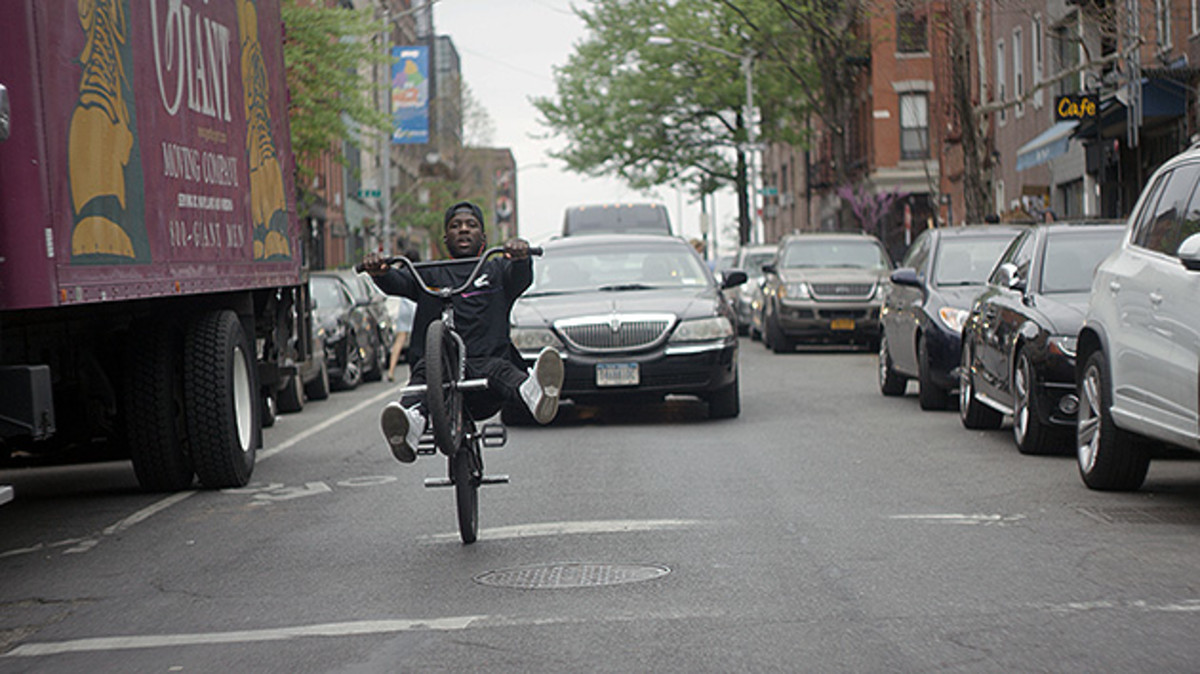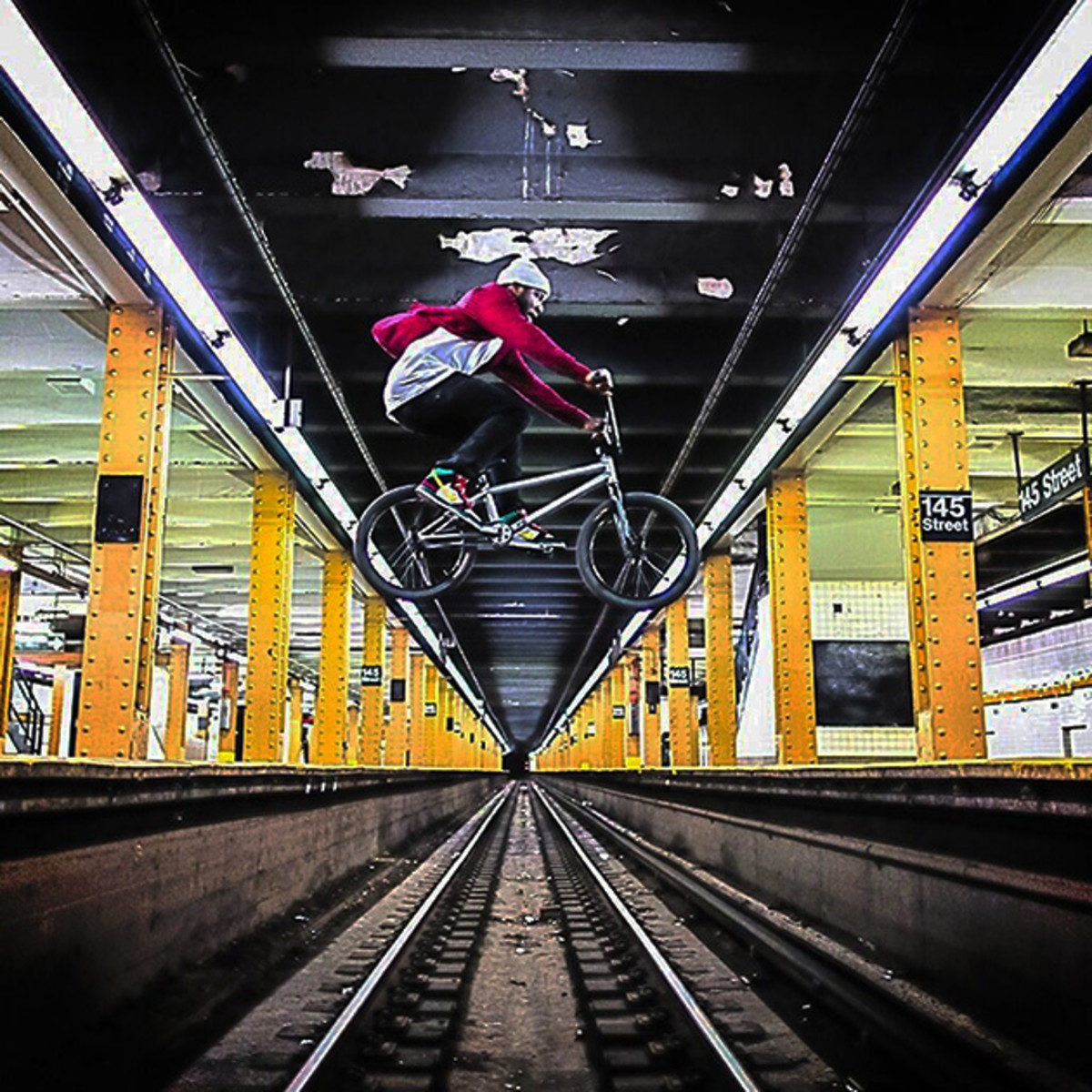Training with Nigel Sylvester: Riding in NYC with BMX’s most gifted athlete

When you first meet Nigel Sylvester, it would be easy to assume he’s an NFL wide receiver or an NBA small forward—the prototypical modern athlete who likely takes advantage of performance enhancing technology to hone his craft, following unique training programs designed to produce the chiseled, 5'9" 185-pound athlete sitting next to you.
But the 27-year-old kid from Jamaica, Queens, rolling down the skinny streets of Williamsburg in a shiny BMW coupe, doesn’t play football. He’s a world-class BMX practitioner, cultural icon and one of the most naturally gifted athletes in the sport. Just ask him about being compared with guys in the NFL and Sylvester’s quick to explain that an analysis of his biometric performance data has proven that he does, in fact, measure up with other pro athletes.
Training with Byron Jones: Breaking records and rising up NFL draft boards
“It takes just as much mental and physical toughness to go out and do we what we do,” says Sylvester. “Bike control is so important. Being able to maneuver without brakes, and muscle that bike around and stop on the drop of a dime.”
As startlingly fit as Sylvester may seem to be for a BMX rider, it’s even more surprising when he explains that he doesn’t spend a single minute in the gym. Instead, he has developed his physical prowess and razor-sharp spatial awareness simply by riding, a lot. “BMX is a lifestyle sport,” says Sylvester. “It’s part of my everyday life. There’s not a day that goes by that I don’t touch my bike, ride it to the store or go out and have a full session.”
When you see Sylvester ride his 24-pound, Brooklyn Machine Works bike in the epic short films he produces (he doesn’t compete in any BMX competitions), his superior level of control, both mental and physical, quickly becomes evident. “You use every single muscle and bone in your body when you go out and ride,” says Sylvester. “Your legs, back, core… your brain. Every muscle is being worked constantly. You’re always being pushed to the limit every single day, and there are no off-days.”

Whether he’s jumping down a handrail or launching over a gap, it takes a certain kind of strength and poise to follow through and finish the way Sylvester does. “We may play different sports, but I compare Peyton Manning throwing a 65-yard bomb for a touchdown to me going down a 15-stair handrail and doing a tail whip out,” says Sylvester as he laughs about how crazy he must sound for comparing himself to an NFL legend. “There’s just a certain mindset, and a certain physical shape you have to be in to go out and execute those things.”
On the streets of New York City, Sylvester has a different playing field than most athletes in other pro sports, which makes attributes like agility and reaction time even more important. “When I’m going through the city, between cabs and buses, or even just through [crowds of] people,” says Sylvester, “my mind is moving so fast. Your hand-eye coordination has to be so good to move in a split-second.”
Sylvester usually rides down the streets going anywhere from 15 to 25 mph, which he does without the luxury of brakes, providing the need for an extra layer of concentration and the ability to react. “If I’m blasting down Seventh Avenue and I get to 34th Street around rush hour, there’ll be hundreds of people crossing the street,” he says. “You have to pick the passageway you can fit through. It’s like a running back when he sees that hole and just blasts through it.”

Since the 27-year-old phenom doesn't spend his time winning trophies at organized BMX events around the world, it's safe to wonder how he has become one of the most popular riders in the sport. The publicity may not come from posting the highest score in skills competitions, but the feats that Sylvester is accomplishing on a daily basis in his journey to BMX immortality are astonishing. From mastering his technical approach to BMX with ridiculous trick combinations in high quality video edits to pulling off daredevil attempts like jumping the subway track (see photo above) at the 145th Street station in Harlem, Sylvester has made a name for himself beyond the traditional scene.
“This is not a basketball court or a football field where everything is controlled,” says Sylvester. “Everyday is different, every pedal is different. That’s what I love about it.”
Read and React
Alise Post, a U.S. Olympian and seven-time BMX world champion, offers up a few drills that will help develop pro-BMX-level balance and reflexes
1. BOSU Ball Single-Leg Balance, Single-Hand Tennis Ball Catch
This exercise will help when trying to stay calm while reacting to unexpected situations. “It is performed by balancing on one leg on the flat side of a BOSU ball, facing a wall, hands relaxed at your side,” says Post. Have a partner throw a tennis ball at the wall from behind you, then catch the ball on the rebound with one hand, all while remaining balanced on your one leg. Repeat on both legs. The speed of the exercise can increase as you progress by having your partner throw the ball faster and/or varying your distance from the wall.
2. Medicine Ball Balance Training
Balancing on a medicine ball can dramatically improve an athlete’s reaction time and agility. Athletes can progress “from a softer ball to a harder ball, as well as from jumping forwards onto the ball, to then jumping from all different angles onto the ball.” Once sturdy and comfortable, progress to doing single leg balancing and squatting. Then, move on to advanced techniques such as rolling the ball and trying to jump on it while it is in motion. After you’ve conquered that, jumping from ball to ball will improve reactiveness and agility.
3. Medicine Ball Plyometrics
This exercise takes the standard box jump to a whole new level, and requires a lot of core strength, balance, and concentration. It is performed by balancing on a medicine ball—and, again, you can start with a softer ball for safety until you are comfortable with your medicine ball balance. You then choose a plyo box of your desired height (start low), and jump directly from your medicine ball onto the plyo box. “Make sure you are steady before jumping off the med ball, or else the ball may abruptly shift underneath you as you try to jump, and you might find yourself on the ground!”
- MORE EDGE:X Games, Point Break movie, Mountain Games, more
Working hard at the gym? Training for that first (or fifteenth) marathon? SI wants to train with you! Head to Twitter or Instagram, upload a photo of yourself getting fit and give us a little insight into why/what you train for. Include the hashtag #trainingwithsi and your photo could be featured in an upcoming issue of Sports Illustrated. Click here for Contest Rules.
